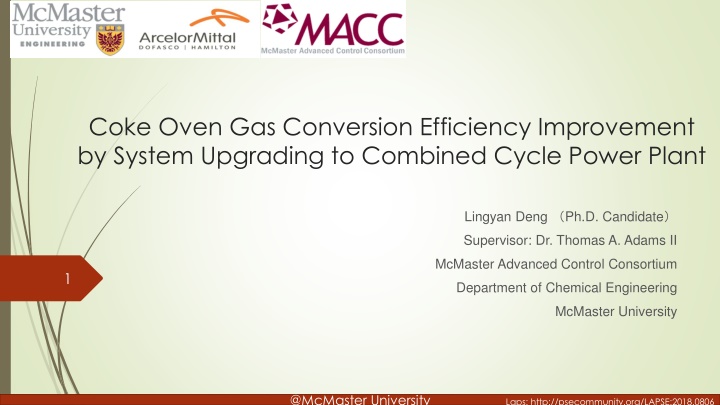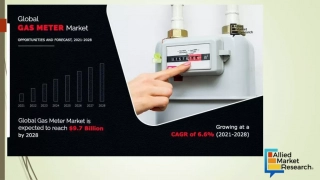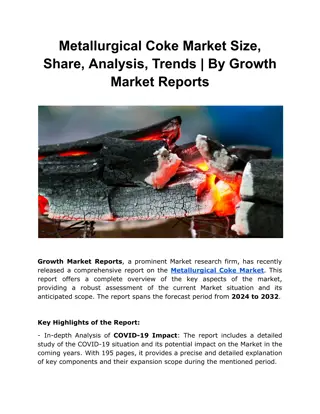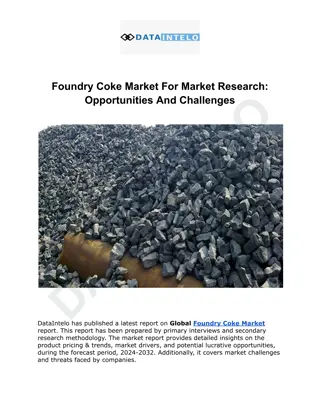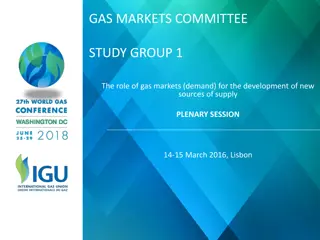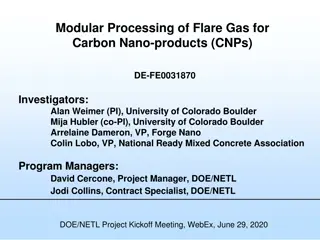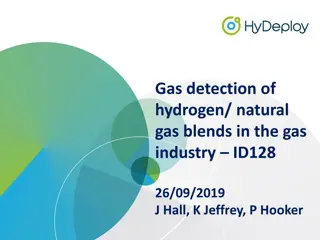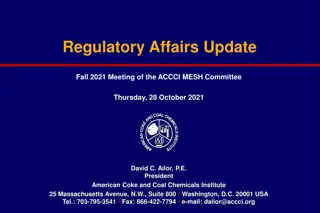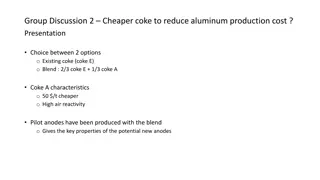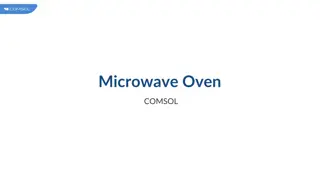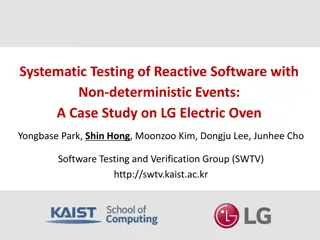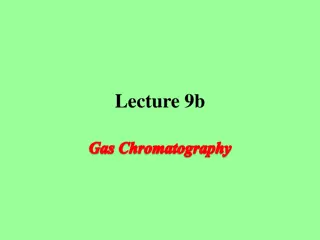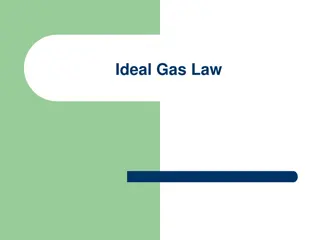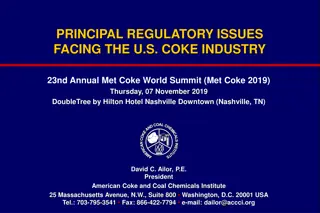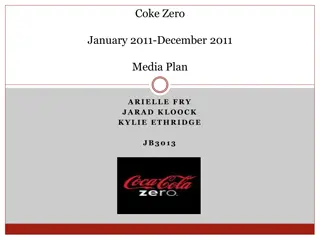Coke Oven Gas Conversion Efficiency Improvement by System Upgrading
This study focuses on enhancing the efficiency of coke oven gas conversion by upgrading to a combined cycle power plant. It explores the composition and utilization of coke oven gas, H2S removal processes, and the status quo versus proposed utilization methods. The aim is to reduce CO2 emissions and energy costs in the steel industry.
Download Presentation

Please find below an Image/Link to download the presentation.
The content on the website is provided AS IS for your information and personal use only. It may not be sold, licensed, or shared on other websites without obtaining consent from the author.If you encounter any issues during the download, it is possible that the publisher has removed the file from their server.
You are allowed to download the files provided on this website for personal or commercial use, subject to the condition that they are used lawfully. All files are the property of their respective owners.
The content on the website is provided AS IS for your information and personal use only. It may not be sold, licensed, or shared on other websites without obtaining consent from the author.
E N D
Presentation Transcript
Coke Oven Gas Conversion Efficiency Improvement by System Upgrading to Combined Cycle Power Plant Lingyan Deng Ph.D. Candidate Supervisor: Dr. Thomas A. Adams II McMaster Advanced Control Consortium 1 Department of Chemical Engineering McMaster University @McMaster University Laps: http://psecommunity.org/LAPSE:2018.0806
Introduction 2 Figure1. Overview of the two main methods of steelmaking process (Resource: worldsteel) Steel industry emits tremendous CO2 each year. Around 1.9 ton of CO2 per ton of pig iron produced. By-product off-gas (mainly: COG, BFG, and BOFG) are not efficiently used yet. They are to provide heat in the refining process. Hence carbon are released as CO2. Off-gas utilization is aimed to reduce CO2 emission and lower down energy cost. @McMaster University Laps: http://psecommunity.org/LAPSE:2018.0806
Coke Oven Gas (COG) Composition & Utilization 3 Component COG Temperature ( C) 35.0 Half of NG Pressure (bar) 1.4 HHV (Btu/ft3) 400-570 HHV (MJ/kg) 22.6-32.4 Chemical Composition (volume fraction) Options of Off-gas valorization %C2H2 %CH4 %CO 1.5-3 1. Produce more electricity by upgrade to 22-28 5-9 combined cycle power plant (CCPP) %CO2 %H2 %N2 %O2 1-3.5 2. Synthesize it into methanol (MeOH) 45-60 3. Synthesize it into methane 3-6 0.1-1 4. Extract H2 out of it H2S (ppmv) CS2 (ppmv) 3420-4140 82-92 Thiophene (C4H4S) (ppmv) 26-34 Nonnegligible amount of sulfur content @McMaster University Laps: http://psecommunity.org/LAPSE:2018.0806
H2S Removal Process Chosen 4 Solvent Rectisol MDEA MEA DGA Solvent type Physical Aqueous Amine Aqueous amine Commercialized for post- combustion Commercialized for NG sweeting Typical Application Coal to MeOH IGCC Relative volatility (Chemical / Solvent) at 16 bar Temperature range ( C) -60.0 to 150 -70.0 to 410 -80.0 to 300 -70.0 to 370 H2S CS2 C4H4S 127 5000 1.93 458 3.60 108 8.62 33.0 369 6.90 107 28.9 199 42.5 7.27 104 7.87 19.4 --- 5.58 9.56 20.0 25.5 4.97 6.20 Pressure (bar) Absorber 17.0 16.2 1.00 1.00 3.40 17.0 2.00 - 1.00 Stripper MEA and MDEA have high relative volatility MEA is recommended when CO2 is not present due to it low selectivity difference for CO2 and H2S DGA select CO2 over H2S. And prefer low pressure @McMaster University Laps: http://psecommunity.org/LAPSE:2018.0806
Off-gas Utilization Status-quo and Proposed CCPP 5 Flue gas Status quo Steel products Work Boiler Status Quo Proposed CCPP S/T Choice Pump Cond. By-product COG Pressure Low High Proposed CCPP Comb. Turbine LP S/T G/T, HP, IP, LP S/T Desulphur Air Work H2S G/T Desulphurization Without Additional With Additional Work S/T System optimization Not sure Yes Cond. Pump Flue gas @McMaster University Laps: http://psecommunity.org/LAPSE:2018.0806
Proposed Combined Cycle Power Plant 6 Objective: maximize NPV Variables: HX areas Process Water flow rate Split factors Method: Aspen Plus give rigorous mode. GAMS surrogate model used to do system optimization Steam Cold water Gases @McMaster University Laps: http://psecommunity.org/LAPSE:2018.0806
CCPP Optimized by GAMS 7 Component Description GAMS Aspen Plus Error (%) It is a Nonlinear Program Marginal Temperature of EXHAUST1 ( C) Temperature of EXHAUST2 ( C) Temperature of EXHAUST3 ( C) Temperature of EXHAUST4 ( C) Temperature of EXHAUST5 ( C) Temperature of EXHAUST6 ( C) Temperature of EXHAUST7 ( C) ??1 1240 1240 0.00 - Constrants: ??2 692 692 0.00 - Mass balance Energy balance ??3 634 634 -0.01 - ??4 599 599 -0.02 - 1. Initial guess from Aspen Plus 2. IPOPT used to find all variables initial guess 3. CONOPT used to find local optimum 4. BARON used to find the global optimum 5. Global optimum condition put back into Aspen Plus 6. Compare GAMS with Aspen Plus ??5 510 511 -0.04 - ??6 445 446 -0.15 - ??7 191 190 0.41 - Temperature of STEAM6 ( C) 206 205 0.32 6 ??2?,???. - Total Power Generated MJ/kg COG 25.9 25.9 0 - Total Net Work MJ/kg COG 13.3 13.3 0 - Total HX. Area Total HX. Area (m2) 2150 2180 -1.15 0.005 Topping Net Work Bottoming Net Work MJ/kg COG 7.93 7.93 0 - MJ/kg COG 5.40 5.38 0.37 - @McMaster University Laps: http://psecommunity.org/LAPSE:2018.0806
Economic Analysis 8 Purchase cost equations are used to estimate the equipment purchasing cost [1] Operation cost, production cost are estimated according to Seider s book [1] The cost are converted to 2016 via CEPCI A lifetime of 30 year, and 15% internal rate of return are assumed 1. Seider, W. D.; Seader, J. D.; Lewin, D. R.; Widagdo, S. Product and Process Design Principles: Synthesis, Analysis and Evaluation; John Wiley & Sons, Inc., 2009. @McMaster University Laps: http://psecommunity.org/LAPSE:2018.0806
Results and Discussion 9 Proposed COG CCPP Status Quo 68.5 0 Total Capital Investment (million $) 31.4 0 Total Operation Cost ($/kW) 288 0 Total Production Cost ($/kW) 512 0 Total Revenue ($/kW) 5.77 0 Payback period (yr) 0 Net Present Value (million $) 9.51 Installation cost ($/kW) 1107 0 NPV: $9.51 million with $68.5 million in capital investment Net lifecycle CO2 emissions reduced is 84.1 gCO2e/kg COG @McMaster University Laps: http://psecommunity.org/LAPSE:2018.0806
Location Effects 10 Ontario, Canada USA Finland Mexico China Units Purchasing power parity 1.27 1 0.905 8.57 3.47 LCU/USD Electricity carbon intensity 40 588 285 856 1064 g/kWh Carbon tax 18.1 0 29.3 3.70 0 $/tonne Electricity pricea 0.112 0.108 0.175 3.65 0.660 LCU/kwh NPV 9.51 19.5 164 286 115 million USD Payback period 5.77 4.82 1.63 0.53 1.30 yr a: LCU = local currency unit (Canada in CAD, USA in USD, Finland in Euro, Mexico in MXN, and China in RMB). @McMaster University Laps: http://psecommunity.org/LAPSE:2018.0806
Conclusions 11 A combined cycle power plant is proposed and optimized for coke oven gas utilization Additional NPV is about 9.5 million $. Net lifecycle CO2 emissions reduced is 84.1 gCO2e/kg COG It might not be a good idea to do it in Ontario, Canada But It a good idea to upgrade it in Finland, Mexico, and China @McMaster University Laps: http://psecommunity.org/LAPSE:2018.0806
Acknowledgement 12 This invited contribution is part of the I&EC Research special issue for the 2018 Class of Influential Researchers. Helpful collaborations and data from Ian Shaw and David Meredith (AMD) are gratefully acknowledged. This research was funded by the McMaster Advanced Control Consortium, of which AMD is a member. @McMaster University Laps: http://psecommunity.org/LAPSE:2018.0806
13 Thank you for your attention! @McMaster University Laps: http://psecommunity.org/LAPSE:2018.0806
For More Details About This Topic 14 Please Refer to the full paper: Optimization of Coke Oven Gas Desulfurization and Combined Cycle Power Plant Electricity Generation Lingyan Deng and Thomas A. Adams II Industrial & Engineering Chemistry Research 2018 57 (38), 12816-12828 DOI: 10.1021/acs.iecr.8b00246 @McMaster University Laps: http://psecommunity.org/LAPSE:2018.0806
